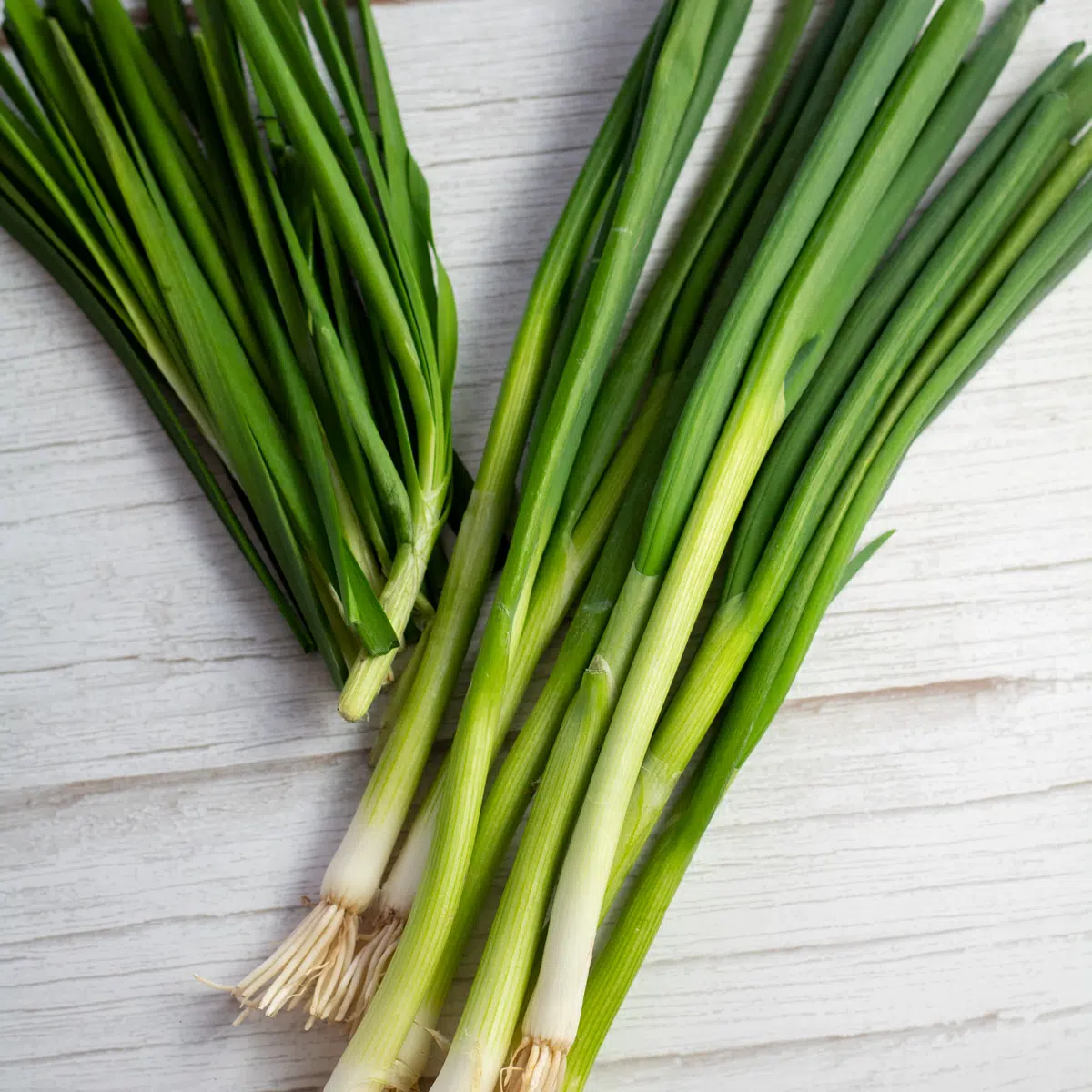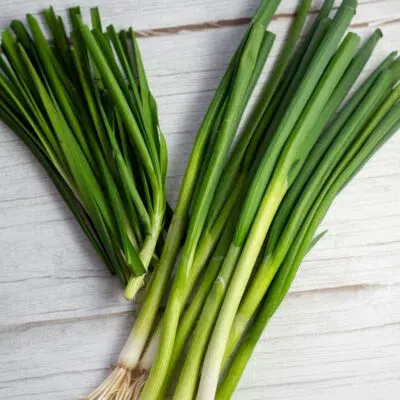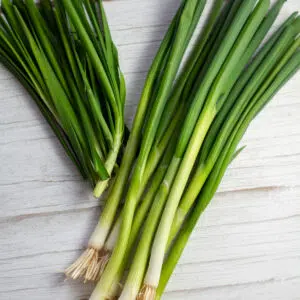Green onions vs chives- many people think they are the same thing but I'm here to tell you about their wonderful differences! Yes, there are many similarities, but knowing the difference between green onions and chives can help you follow recipes as accurately as possible!

How to easily distinguish between green onions and chives!
Green onions and chives - two foods that often get mistaken for one another. Both help to enhance the flavor of a variety of dishes. Both are green and stalky. And both are delicious on top of a baked potato!
While these two little green giants have some similarities, they are each quite unique. Most importantly, they are not the same thing.
Jump to:
Therefore, understanding the differences between green onions and chives can help you use each to its fullest potential. It can also help you substitute one for the other in certain dishes.
How do you know which to use when it comes down to green onions vs chives?
What are Green Onions?
Green onions are distinguished by their long green stalks that have a small white bulb - that looks like an onion - at the bottom. It's not just that it looks like an onion, it is an onion!
The small onion at the bottom is technically a "young onion." It is an immature white onion that is pulled from the ground before it has fully grown. This is also why the little bulbs still have roots growing from the bottom.
Green onions, just like their larger cousins, are types of allium plants. The allium family includes all varietals of onions - green, white, yellow, red - as well as garlic, shallots, and leeks. Chives are also part of this flavor-filled family (but more clarification on that later).
Green Onions vs Scallions
While chives are not the same as green onions, there is another food green onions get mistaken for - scallions. This one is not a mistake though; green onions and scallions are basically the same things.
Two small technical differences distinguish between the two. One is simply the difference in what type of species the green onion is. The second is when they are harvested. Scallions are technically harvested a bit earlier than green onions.
Overall, the term "green onion" is an umbrella term for any young onion. This could be a green onion, spring onion, or scallion.
When it comes down to it though, they are all the same! So, feel free to use scallions and green onions interchangeably without giving it a second thought.
What do Green Onions Taste Like?
You probably already guessed it, but green onions taste a bit oniony. The white bulb at the bottom offers the most onion-like taste. It is not quite as pungent as a standard white or yellow onion though.
The green part is much milder than the bulb at the bottom. They are more fresh tasting, yet still offer a hint of the onion.
While green onions are less pungent than a full-grown onion, these little guys can work in a pinch as in certain dishes. They can even be used as a substitute for shallots.
How to Use Green Onions
Beyond their ability to be swapped in as a substitute in certain recipes, green onions are quite versatile on their own. They are unique from other members of the allium family because there are two parts, the bottom, and the top.
Each part can be used on its own or the entire stalk and bulb can be used together. The two parts of the plant also allow you as the chef to control how much of the oniony taste you want to come through in a dish.
Most recipes simply call for green onion. How you use that green onion is up to you!
If you want a stronger flavor, you may find you use only the white bulbs from several stalks. On the other hand, for a milder taste, you may use several chopped-up green stalks with only one white bulb.
If you are just looking for a garnish, you may only use the leafy green stems. The variety of flavors allows for green onions to be used in so many ways!
Popular Uses for Green Onions
The bulbs of green onions are commonly used in Asian cuisine. They help elevate and balance the flavors of hot dishes like stir-fries, without overpowering them the way a regular white onion may.
In addition to Asian dishes, the bulbs are delicious in soups and stews. Again, being a popular choice for when you want a hint of onion but do not want it to take over the flavor of the whole dish.
Beyond the bulbs, the leafy green stalks are a delicious addition to salads and other cold dishes. The bulbs are also a nice addition to a salad!
Tip for using green onions
One important thing to remember is to wash these little onions well before using them. The nature of their bulbs and stalks can trap dirt easily, so give them a gentle soak and rinse before enjoying.
What are Chives?
With a better understanding of green onions, it is easier to understand how chives are different. One of the easiest ways to distinguish between green onions and chives is to simply look at them.
While both have long leafy green stems, chives are much thinner and often a deeper green than green onions. In addition to the thinner green stems, chives are typically not sold with the bulb still attached.
Unlike green onions, the bulb of the chive is not commonly used in the kitchen; therefore, it is removed when the chives are harvested for sale.
Beyond the visual differences, there is a distinct and important difference between chives and green onions. Chives are an herb and not an onion.
So, while they are a flavorful herb that is used in similar ways, they are not onions.
What do Chives Taste Like?
Although chives are herbs and not a member of the onion family, they are still closely related since they fall into the allium varietal of flowering plants. In fact, they are often described as having a mild onion flavor profile.
Since chives are an herb, they are commonly used as both a fresh herb and a dried herb. Fresh chives offer a more pungent onion-like taste, while dried chives are much milder.
Chives can also be added to hot dishes which will provide a more subdued flavor that is similar to the dried herb.
How to Use Chives
Fresh chives are commonly used as a garnish in a variety of dishes. They pair well as a savory addition seafood and poultry dishes, as well as with cheese and eggs.
Let's not forget a family favorite, chives on top of baked potatoes!
While chives lose some of their flavor when cooked, they are still a popular seasoning used to enrich the flavor of cream sauces and soups. This is especially common in Europe.
Another delicious way to use chives is to mix them with cold ingredients. They can add the perfect punch of flavor to a cold salad, such as a pasta salad with chicken or fish, as well as mixed with soft cheeses.
If you have had a chive cream cheese, then you know how delicious this pairing can be!
Knowing When to Use Green Onion vs Chives
When it comes to these two flavor-packed foods, the question most cooks want answered is, can you substitute chives for green onions and vice versa?
Since both chives and green onions offer a mild onion flavor, they can be used as substitutes for one another.
However, there are certain types of dishes where substitutions will work better than others. Overall, the best dishes to substitute chives for green onions or vice versa are dishes that call for raw chives or green onions.
Think cold dishes like salads, or as a garnish. In these types of dishes, you can easily swap between chives and green onions in equal parts.
Substituting Green Onions for Chives
When using green onions in place of chives, focus on using a combination of both the leafy green stem and the onion bulb for the closest result. When it comes to cooking with these two ingredients, you can still substitute one for the other, but it will not be an exact flavor match.
Chives lose more of their flavor when cooked, compared to green onions. Therefore, if you use chives in place of the green onion in an Asian stir-fry, there will not be the same strong aroma or flavor.
If you need a substitute for green onions in a hot dish, it is often better to use a small amount of white onion. This will provide a stronger onion taste than chives.
On the other hand, if you need a replacement for dried chives, another dried herb is better than green onions. Fresh green onion will most likely overpower the dish; therefore, using an herb like dried parsley as a substitute will provide a closer flavor exchange.
Even though these two can be substituted for one another, if you have the chance to try each one in a dish that is meant to highlight their individual flavors, you are in for a delicious experience.
If you enjoyed this article about green onions vs chives, let us know in the comments below so we can write more like it!
Do you love a recipe you tried? Please leave a 5-star 🌟rating in the recipe card below and/or a review in the comments section further down the page.
Stay in touch with me through social media @ Pinterest, Facebook, Instagram, or Twitter! Subscribe to the newsletter today (no spam, I promise)! Don't forget to tag me when you try one of my recipes!
📖 Recipe Card
Green Onions vs Chives: Sour Cream & Chives Scrambled Eggs
Ingredients
- 6 large eggs
- 3 tablespoon butter (divided into 3 portions, 1 tablespoon each)
- ½ teaspoon salt
- 3 tablespoon sour cream
- ½ tablespoon chives (fresh, chopped)
(Note: 2x or 3x only changes the ingredient list)
Instructions
- First, in a bowl whisk the eggs until light, fluffy, and frothy. Then, whisk in the salt, sour cream, and fresh chopped chives. Do not add pepper before the eggs are done cooking (*see note).
- Heat a skillet over medium heat, then add the whisked egg mixture. Pour the egg directly into the middle of your skillet then add the first 1 tablespoon portion of butter.
- Use a spatula to gently slide the eggs across the bottom of the skillet, moving the cooked egg portions so that the folded up on one side and the uncooked egg fills in the cleared space in your skillet.
- Halfway through cooking when the eggs are semi-solid, add in 1 more portion of the butter. Continue moving the eggs around as they firm up. Once they are starting to look like scrambled eggs, add the final portion of butter.
- Remove from heat and serve immediately.
Notes
- When added to uncooked eggs, pepper will turn them gray. Add pepper after the eggs are done cooking if desired.
- Using a whisk, rather than a fork, to beat the eggs will more evenly distribute the egg whites and yolks.
- Higher fat butter, like European-style butter, will produce richer scrambled eggs.



Gonçalves says
Bom dia! Tenho cebola branca na horta as folhas crecem muito e pouca cabeça!diferente das outras ! Obrigado!
"Good morning! I have white onions in the garden, the leaves grow a lot and little head! Different from the others! Thanks!"